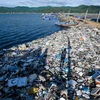The southern province of Hau Giang has been chosen as a model to devise a master plan for biomass energy by the German development agency GIZ, considering its abundant source of solid farming wastes.
Hau Giang relies solely on agriculture for economic growth with 200,000ha of rice and 12,000ha of sugarcane, generating tens of thousands of tonnes of straws and bagasse – key materials for producing power.
At a workshop to launch the work on the master plan in Hau Giang on October 29, Director of the New and Renewable Energy Department, an arm of the Ministry of Industry and Trade (MoIT), Pham Trong Thuc said the plan should be completed by February next year.
The plan will assess the potential of the existing biomass, outline the rule to use this source of energy and consider possible impacts on greenhouse gas emission, he said.
During the workshop, technical experts from GIZ presented an overview of the Vietnam – Germany renewable energy development project and the role of biomass in Vietnam’s sustainable development strategy.
Nguyen Duc Cuong, Director of the Centre for Renewable Energy and Clean Development Mechanism under the Institute of Energy, said biomass reserves in Vietnam are estimated at 150 million tonnes a year, equivalent to 50 million tonnes of crude oil. Besides bagasse and rice husk, all kinds of fiber and waste from agricultural and forestry activities after harvest could be used as fuel for electricity generation.
The country is also seeking to develop other sources of renewable energy, such as bio-gas and waste energy.-VNA
Hau Giang relies solely on agriculture for economic growth with 200,000ha of rice and 12,000ha of sugarcane, generating tens of thousands of tonnes of straws and bagasse – key materials for producing power.
At a workshop to launch the work on the master plan in Hau Giang on October 29, Director of the New and Renewable Energy Department, an arm of the Ministry of Industry and Trade (MoIT), Pham Trong Thuc said the plan should be completed by February next year.
The plan will assess the potential of the existing biomass, outline the rule to use this source of energy and consider possible impacts on greenhouse gas emission, he said.
During the workshop, technical experts from GIZ presented an overview of the Vietnam – Germany renewable energy development project and the role of biomass in Vietnam’s sustainable development strategy.
Nguyen Duc Cuong, Director of the Centre for Renewable Energy and Clean Development Mechanism under the Institute of Energy, said biomass reserves in Vietnam are estimated at 150 million tonnes a year, equivalent to 50 million tonnes of crude oil. Besides bagasse and rice husk, all kinds of fiber and waste from agricultural and forestry activities after harvest could be used as fuel for electricity generation.
The country is also seeking to develop other sources of renewable energy, such as bio-gas and waste energy.-VNA



















